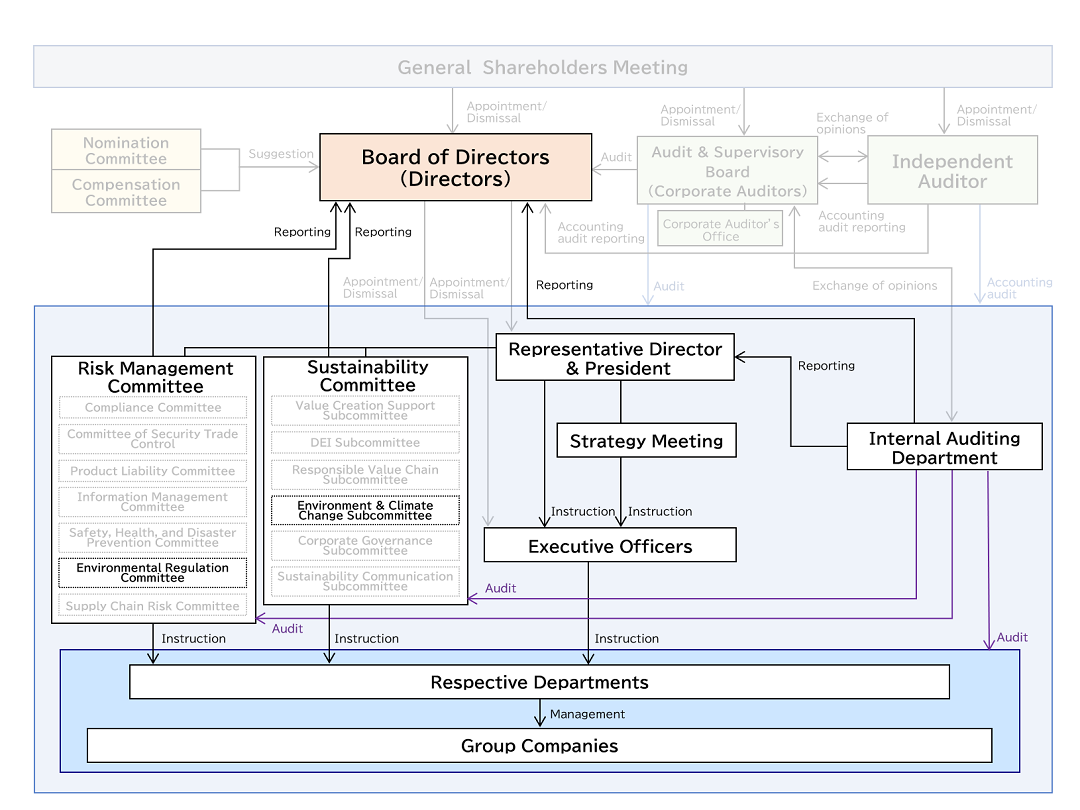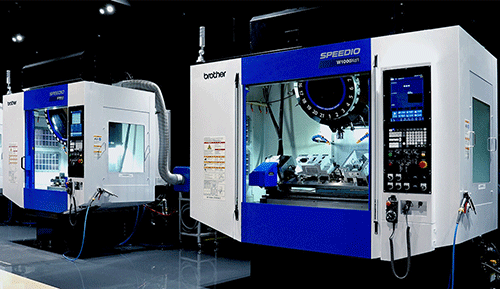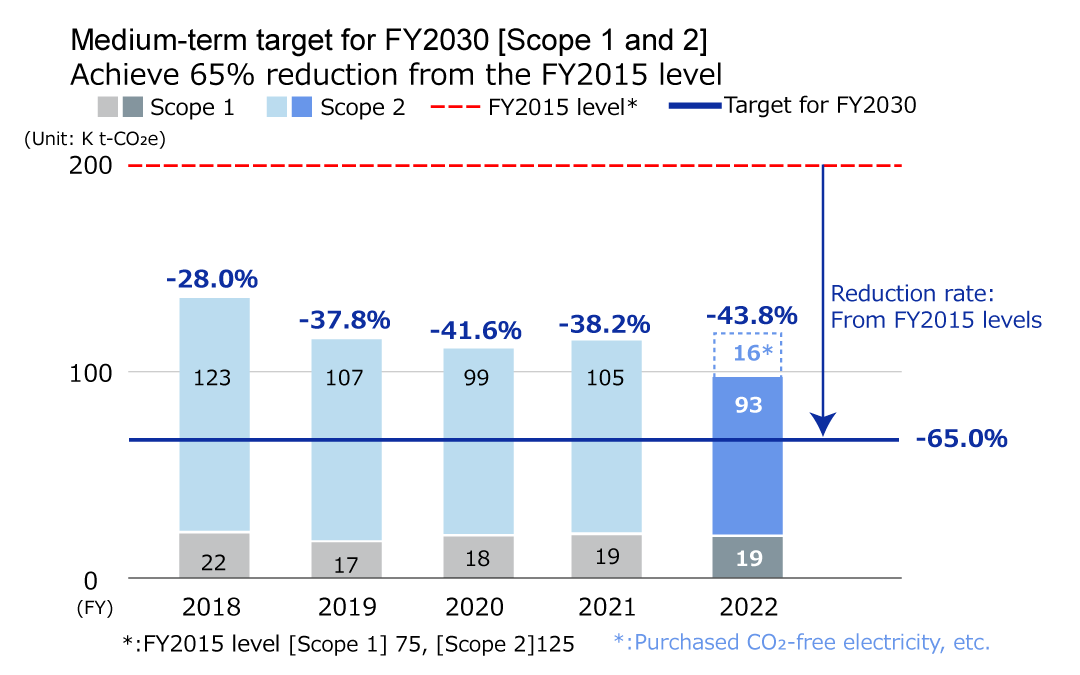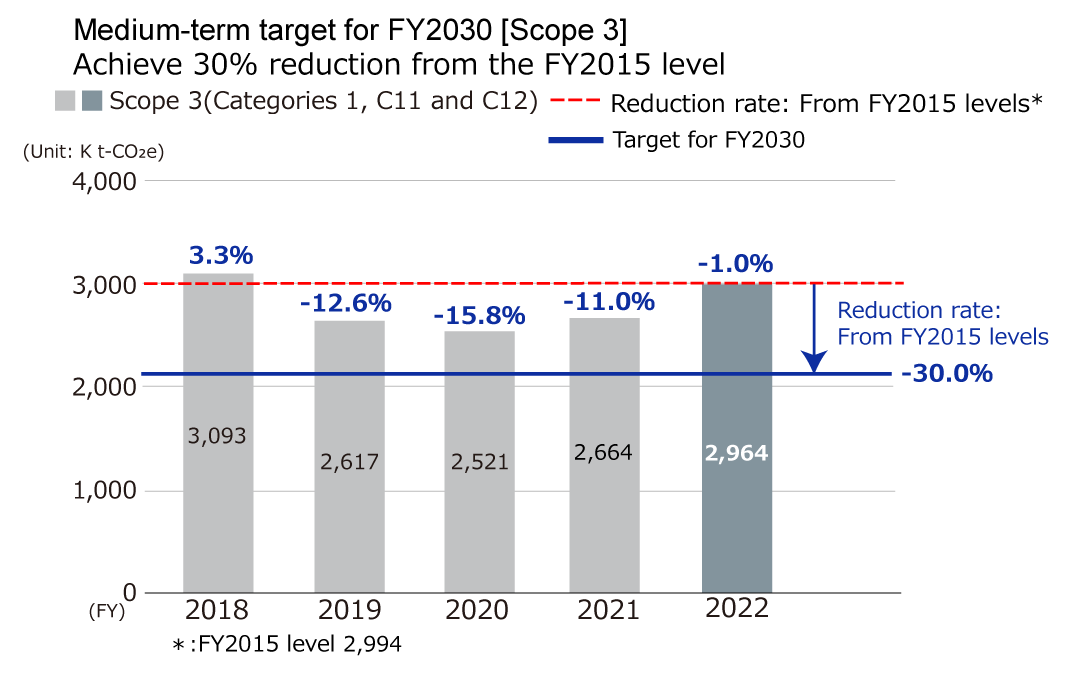Response to Climate Change
The Brother Group, as a global company, has placed the highest priority on efforts to respond to climate change. As part of our efforts to achieve this, we have been implementing a diverse range of eco-friendly activities and environmental technology development in all manufacturing processes, including development, procurement, production, sales, and logistics. In carrying out these measures, we emphasize one of our basic policies in the "Brother Group Global Charter" formulated in 1999: "The Brother Group shall positively and continuously act to decrease the environmental impact of all aspects of our business operations so that society can achieve sustainable development." Since formulating these policies, we as the Brother Group have set medium-term environmental goals and promoted ongoing activities to meet them. Thanks to the efforts of each Group member, we have made steady headway toward achieving these goals.
In 2018, the Brother Group formulated the Brother Group Environmental Vision 2050, which made reducing CO2 emissions a key item. We have also set the milestone "Medium-term Target for 2030" consistent with the Paris Agreement, which is a global framework for controlling climate change (global warming). In March 2025, we revised the CO2 emissions reduction targets in the Brother Group Environmental Vision 2050, and the revised medium-term target has been recognized by the Science Based Targets initiative (SBTi), an international initiative, as reduction targets based on scientific evidence to achieve the "1.5°C target" of the Paris Agreement. We have been carrying out CO2 emissions reduction activities to achieve these targets. The Brother Group is working on formulating a transition plan to further promote activities to build a carbon-free society and will continue to make various efforts to contribute to solving the issue of global climate change.
History of our climate change countermeasures
| 1999 | The Brother Group Global Charter is formulated. |
|---|---|
| 2009 | Brother's "Medium-term Target for FY2020," the CO2 reduction targets to be achieved by FY2020, is established, and efforts to reduce CO2 emissions are initiated. |
| 2013 | The scope of CO2 emission reduction activities is expanded to the entire Group, and CO2 emission calculations and reductions not only from Brother but also throughout the entire product supply chain are started. |
| 2018 |
The "Brother Group Environmental Vision 2050" is established, and the "Medium-term Target for 2030" is set as a milestone for this vision. |
| 2020 | Brother Industries, Ltd. supports the recommendations by the Task Force on Climate-related Financial Disclosures (TCFD). Brother analyses the risks and opportunities of climate change for key businesses based on the recommendations by the TCFD. |
| 2021 | Disclosure of relevant information based on TCFD recommendations. Targets for CO2 emission reductions (Scopes 1 and 2) in "the Brother Group Environmental Vision 2050" are revised. |
| 2022 | The CO2 emissions reduction targets in "Medium-term Target for 2030" under the revised Environmental Vision receive certification as "1.5°C Target" by the international initiative "Science Based Targets initiative (SBTi)." Targets for resource circulation in "the Brother Group Environmental Vision 2050" are revised. |
| 2025 | The Brother Group analyses the risks and opportunities that climate change poses to all businesses and expands disclosure of related information based on the recommendations of the TCFD. The FY2030 medium-term targets for CO2 emissions reduction (Scope 3) and resource circulation set forth in the "Brother Group Environmental Vision 2050" are revised. |
Compliance with the TCFD Recommendations and Further Promotion of Climate Change Countermeasures
The Brother Group has identified the reduction of CO2 emissions as one of the materialities (priority social issues to be solved) in order to contribute to society and protect the earth, and has set sustainability targets. In February 2020, the Brother Group expressed our support for the recommendations made by the Task Force on Climate-related Financial Disclosures (TCFD).

Based on these TCFD Recommendations, the risks and opportunities of climate change with regard to our Printing & Solutions Business, Machinery Business, Personal & Home Business, and new businesses were analyzed, and relevant information was disclosed in FY2021. In FY2024, we expanded the scope of businesses subject to analysis, analyzed all of the Brother Group's businesses,* and disclosed the results of the analysis in FY2025.We will expand the scope of businesses subject to analysis and strive to enhance our information disclosure as well as further stepping up our climate change countermeasures in order to contribute to the formation of a decarbonized society.
- Printing and Solutions Business, Machinery Business, Domino Business, Nissei Business, Personal and Home Business, Network and Contents Business and New Businesses
- To visit TCFD website (the link to the site of "TCFD")
- TCFD Recommendations: Strategy (scenario analysis)
- TCFD Recommendations: Metrics and Targets
TCFD Recommendations: Governance
The Brother Group has established a Sustainability Committee, chaired by the Representative Director & President, to globally promote management with an emphasis on sustainability, including activities to address materiality issues. The Sustainability Committee has five subcommittees, including the Environment & Climate Change Subcommittee, which addresses environmental issues such as climate change and biodiversity, and the Responsible Value Chain Subcommittee, which promotes respect for human rights and creation of a safe working environment, each of which is responsible for managing progress toward its targets and promoting its activities. The person in charge of a subcommittee regularly reports the status of its activities to the Sustainability Committee, and the President as the chairman, or a person designated by the President, reports on activities to the Board of Directors at least once a year.
When it becomes necessary to formulate or revise important matters regarding climate-related environmental risks or environmental issues, they are examined by subcommittees as well as the Sustainability Committee, deliberated at the Strategy Meeting, and then resolved by the Board of Directors. The Board of Directors provides guidance and supervision on the content of the matters and strives to strengthen the company-wide promotion system. In addition, to increase the effectiveness of the Group's efforts to address climate change, executive compensation is linked to the degree of achievement of key targets.
| [No. of meetings in FY2024] | ||
| Environment & Climate Change Subcommittee | 3 | |
| Sustainability Committee | 19 | 15 meetings related to the Environment & Climate Change Subcommittee: Reporting and deliberation on the results of the assessments of materialities, including climate change, reporting and deliberation on Scope 3 and resource circulation target revisions, reporting and deliberation on biodiversity conservation, etc. |
| Board of Directors | 1 | Reporting of the Sustainability Committee's activity plan |
Brother Industries, Ltd. Governance Structure (as of June 25, 2025)

TCFD Recommendations: Strategy (scenario analysis)
The "Brother Group Environmental Vision 2050" places the reduction of CO2 emissions as an important matter for the Brother Group. Together with recognizing that climate change, which is becoming more serious around the globe, is an important social issue, we regard climate change as a business risk and opportunity for the Brother Group and are striving to resolve it on a long-term and continuous basis.
In FY2024, the Brother Group identified six key risks and opportunities based on the "1.5°C scenario"*1 and the "4.0°C scenario"*2 for all of its businesses and evaluated their impact on its own operations and finances.*3 The results of this analysis reaffirmed that efforts toward carbon neutrality*4 remain important for the Brother Group in terms of both risks and opportunities. In order to incorporate this into our business strategies and operations, we have included a "commitment to the environment" in the management foundation strategy of our medium-term business strategy, CS B2027, have set a target for CO2 emissions reduction, and are promoting appropriate activities, considering this as an important management issue.
- Scenario in which global warming countermeasures are implemented and a decarbonized society is closer to being realized.
- Scenario in which global warming countermeasures are not taken beyond the current level and temperatures continue to rise further.
- Based on IEA (International Energy Agency) WEO2023 APS (Announced Pledges Scenario) / NZE (Net Zero Emissions by 2050 Scenario), IPCC (Intergovernmental Panel on Climate Change) SSP5-8.5 scenario, Aqueduct (water risk assessment tool), etc.
- Achieve overall zero CO2 emissions from the Brother Group

| Scenario | IPCC AR6 SSP5-8.5 | IEA WEO2023 APS*1 | IEA WEO2023 NZE*2 | |
|---|---|---|---|---|
| Main prerequisites | Temperature rise by 2100 | +4.4°C | +1.7°C | +1.4°C |
| GHG emissions | Net zero emissions not achieved even in 2100 |
Net zero emissions not achieved even in 2100 |
Net zero emissions achieved in 2050 |
|
| Carbon price | Near zero level | Rising from 2030 onwards | Rising from 2030 onwards | |
- APS: Announced Pledges Scenario
- NZE: Net Zero Emissions by 2050 Scenario
Climate-related risks
Scenario and analysis method
Regarding transition risks and opportunities, the Brother Group identified elements necessary for analysis from future forecast data in the IEA WEO2023 scenario (e.g., emission factors, carbon prices) and data published by governments and international organizations (e.g., GDP growth rate) and used that data to calculate the financial impact as a quantitative assessment. We also use the future forecast data in the scenario to better understand the global outlook in 2030/2050 and conduct a qualitative assessment.
For physical risk (acute), we assume a global outlook for 2030/2050 primarily using future forecast in the IPCC AR6 SSP5-8.5 scenario.
Transition risks (Policy and legal risk, changes in the market)
| Changes in the external environment | Financial impact |
Estimated time |
Impact on the Brother Group | Countermeasures | |
|---|---|---|---|---|---|
| Introduction of carbon tax or increase in carbon tax rate | Large | Long-term | Procurement: Significant increase in raw material costs Manufacturing: Increase in energy costs Sales: Increase in transportation fuel costs |
Mitigation |
|
| Strengthening of energy-saving efforts and low-carbon regulations | Low | Medium to Long-term |
Manufacturing: Increase in capital investment, costs for switching to renewable energy, and costs for complying with sustainability-related regulations/disclosure requirements | Mitigation |
|
| Growing demand for environmentally and socially conscious products | Medium | Medium to Long-term |
Sales: Lower revenue if unable to respond to customers’ preferences for environmentally-friendly products and ethical consumption | Mitigation |
|
Financial Impact Low: 1 billion yen or less Medium: 1 to 10 billion yen Large: Over 10 billion yen -: Consider in the future
Estimated Time Short-term: 1 to 2 years based on the fiscal year / Medium-term: 3 to 4 years including the medium-term management strategy / Long-term: 5 years or more including the long-term Group vision
Physical risks (Acute)
| Changes in the external environment | Financial impact |
Estimated time |
Impact on the Brother Group | Countermeasures | |
|---|---|---|---|---|---|
| Increasing severity and frequency of extreme weather events | Large | Short to Long-term |
Production could be suspended due to floods | Response |
|
Financial Impact Low: 1 billion yen or less Medium: 1 to 10 billion yen Large: Over 10 billion yen -: Consider in the future
Estimated Time Short-term: 1 to 2 years based on the fiscal year / Medium-term: 3 to 4 years including the medium-term management strategy / Long-term: 5 years or more including the long-term Group vision
Since it is globally recognized that Japan is prone to natural disasters, we assess the risk of flooding for our domestic business facilities by utilizing hazard maps published by the Ministry of Land, Infrastructure, Transport and Tourism.
For our overseas business facilities, we assess flood risk by using the Aqueduct Water Risk Atlas published by the World Resources Institute (WRI), an international environmental NGO.
Climate-related opportunities
Opportunities (Products and services)
| Changes in the external environment | Financial impact |
Estimated time |
Impact on the Brother Group | Countermeasures |
|---|---|---|---|---|
| Increasing need for customers to cut CO2 emissions | Large | Long-term | Sales: Increase in demand for and sales of energy-saving, energy-creating, and recycling-related products and services, increase in demand for electrification and fuel conversion |
|
| Growing demand for environmentally and socially conscious products | Medium | Long-term | Sales: Increased sales of products and services that contribute to decarbonization (environmental label certification) and increased demand for environmentally compatible products |
|
Financial Impact Low: 1 billion yen or less Medium: 1 to 10 billion yen Large: Over 10 billion yen -: Consider in the future
Estimated Time Short-term: 1 to 2 years based on the fiscal year / Medium-term: 3 to 4 years including the medium-term management strategy / Long-term: 5 years or more including the long-term Group vision
The SPEEDIO series of machine tools is characterized by its high productivity and energy-saving performance. The latest model reduces power consumption by approximately 80% and cycle time by approximately 50% compared to a medium-sized machining center (40-spindle) commonly used for machining large parts, achieving approximately double the productivity. In addition to these energy-saving and highly productive features, the model has been highly praised for its compact and resource-saving design as well as for accurately capturing the changing needs of the world.
On the other hand, Mirai Creation Fund was founded in 2015 with investment from investment advisory companies, automobile manufacturers, and financial institutions. In 2018, a second fund was formed and invested in five areas: intelligent technology, robotics, hydrogen society, electrification, and new materials. In 2021, the third fund, in which Brother has a stake, was launched, and carbon neutrality was added as a new investment theme. Based on its Environmental Vision 2050, the Brother Group has set a carbon neutrality goal for 2050, and through this investment, we will promote the realization of a decarbonized society and technological development.



TCFD Recommendations: Risk Management
The Brother Group regards important social issues such as climate change, resource depletion, environmental pollution, and ecosystem destruction as business risks. As such, the Brother Group Environmental Vision 2050 makes it clear that we will strive to resolve these issues on a long-term, ongoing basis.
In FY2022, the Brother Group established a Sustainability Committee chaired by the president to promote sustainability and risk management, including climate change response, to identify and assess priority climate change risks and opportunities and provide appropriate response instructions. The Environment & Climate Change Subcommittee, established under the Sustainability Committee, identifies key issues such as climate change, determines and implements appropriate countermeasures. In addition, the subcommittee sets ambitious targets for climate change response and monitors progress on a regular basis.
TCFD Recommendations: Metrics and Targets
Under the Brother Group Environmental Vision 2050, in the reduction of CO2 emissions, the Brother Group will aim to achieve carbon neutrality in all business operations and minimize CO2 emissions from the entire value chain by FY2050. In addition, we have set the medium-term target for FY2030, a milestone that is consistent with the Paris Agreement, a global framework for curbing climate change (global warming), to reduce by FY2030, CO2 emissions from the Brother Group (Scopes 1 and 2) by 65% from the FY2015 level and from each stage of the procurement, use, and disposal of products with particularly large emissions in the value chain (categories 1, 11, and 12 of Scope 3) by 28.5% from the FY2022 level.
This medium-term target for FY2030 regarding the reduction of CO2 emissions has been recognized by the Science Based Targets initiative (SBTi), an international initiative, as a reduction target based on scientific evidence to achieve the "1.5°C target" of the Paris Agreement.
Furthermore, short-term targets for 2027 are set in CS B2027 and the Brother Group Environmental Action Plan 2027 as milestones toward achieving the medium-term target for FY2030. They are then broken down into targets for each fiscal year, and the progress and results are reported to the Environment & Climate Change Subcommittee and the Sustainability Committee.

| Issue | Targets for FY2030 | Targets for FY2024 | Progress in FY2024 | Achieve ment |
|---|---|---|---|---|
| Reducing CO2 emissions | [Scope 1,2] Achieve 65% reduction from FY2015 level |
[Scope 1,2] Achieve 47% reduction from FY2015 level |
Achieved 49.7% reduction (from FY2015 level) | ◯ |
| [Scope 3 (Categories 1, 11, and 12)*] Achieve 28.5% reduction from the FY2022 level |
[Scope 3] Implement measures to reduce CO2 emissions by 150,000 tons* |
[Scope 3] Reduced CO2 emissions by 177,000 tons and achieved targets for FY2024 (Achieved 25.2% reduction from the FY2022 level toward targets for FY2030) |
◯ |
[Legend (Evaluation)] ◎: Progress above plan, ◯: Progress as planned, △: Progress behind plan, ×: No progress against plan
- CO2 emissions that are subject to reduction are those related to purchased products and services, the use of sold products, and the disposal of sold products.
Progress in CO2 emission reduction
Progress up to FY2024


In order to reduce CO2 emissions by 2030, we plan to invest several hundred million yen at our business sites in installing solar panels and expanding the use of renewable energy as well as several billion yen to make our products smaller and more energy-saving, and reduce the use of virgin materials.
Click here for a breakdown of Scopes 1, 2, and 3 emissions and the results of external assurance
Internal carbon pricing: As part of our efforts to realize a sustainable society, we have introduced internal carbon pricing (ICP) from FY2024. The ICP targets domestic environmental capital expenditure and sets an internal price for greenhouse gas emissions. To be specific, we set an internal price of 12,000 yen for each ton of CO2 emissions. Based on this price, we make investment decisions that take into account the environmental impact and promote the reduction of greenhouse gas emissions associated with our business activities.
Click here for climate-related coefficient to calculate the executive compensation


